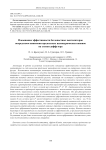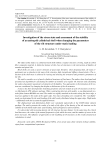Aviation and spacecraft engineering. Рубрика в журнале - Siberian Aerospace Journal

Flow model in the impeller of a centrifugal pump
Статья научная
In accordance with the results of the features analysis of foreign design technology and the creation of aerospace technology products, the certification orientation of all types of work can be traced, starting from the preliminary design stage, which imposes particularly high requirements on the quality of calcula-tion methods, algorithms and software used in the design development of the project. Without the advanced level of domestic developments in the field of modeling hydrodynamic processes in aircraft systems, in the next decade it will become impossible to compete with foreign developers of aviation and rocket-space sys-tems. In accordance with modern theoretical and experimental studies, the flow pattern in the flow path of a vane machine is a complex superposition of the main and secondary flows. The article discusses the method for calculating the fluid flow in the interscapular channel of a centrifugal impeller with a finite number of vanes, the construction of the energy characteristics of the impeller and its optimization by the number of vanes. The calculation consists of two parts: firstly, the determination of the theoretical head taking into account the influence of the finite number of vanes based on analysis of force interaction, and, secondly, determination of hydraulic losses in the impeller by integrating friction stresses along the limit-ing surfaces. The results from both parts are used to optimize the number of vanes in the pump impeller. Analytically, an equation for the pressure at a point and the coefficient of influence of a finite number of vanes are obtained. Taking into account the law of friction, an expression was obtained for the pressure loss. The described method for calculating the spatial boundary layer is quite simple and intuitive, and gives approximate results that make it possible to estimate the required quantities. However, there is a need for further elaboration of the method to bring it to a form that makes it possible to calculate the three-dimensional flow of the working fluid in a channel of arbitrary shape. Based on the results of theoretical studies, an algorithm and a calculation program were developed that allow calculating local values. The results of the calculation of the theoretical head in the impeller can be used for a more accurate calcula-tion of a centrifugal pump.
Бесплатно

Статья научная
The aim of the study is to form an approach to modeling the operations of the orbital assembly of a reconfigurable spacecraft (RS) in geostationary orbit. Reconfigurable spacecraft are a set of modular spacecraft (MS), where, in a particular case, one MS can be assigned the functions of the service systems module (MSS), and the second - the functions of the payload module (MPN). To ensure the assembly of the RC, or the replacement of some MC, for example, in case of its failure with a new one, it is necessary to provide a solution to the problem of bringing the MS with the RS. The article analyzes and studies the operation of the motion control system of the MS during the convergence of the MS with the RS. A list of necessary mathematical models for performing operations in solving the problem of convergence of the MS with the RS is formed, and a block diagram of the interaction of mathematical models is presented. The paper presents a brief description of the mathematical apparatus that allows modeling the operations of convergence of the MS with the RS. This mathematical apparatus includes: a model of the orbital motion of the MS and the RS, models of the angular motion of the MS and the RS, sensitive elements and executive bodies. In this paper, the mathematical modeling of the MS with the RS convergence operations is considered as the subject of research. The object of the study is the motion control system of the MS, which ensures the implementation of the approach of the RS in geostationary orbit.
Бесплатно

Ground control system for distant space vehicle
Статья научная
The demand for research of a promising ground-based long-range spacecraft control complex, which has great capabilities not only in the control of deep space vehicles, but also in carrying out fundamental and applied radio astronomical research. Much attention is paid to the analysis of the requirements to the radio complex, which must be fulfilled to realize the possibility of several directions of scientific research and, first of all: planetary radiolocation; interferometry with ultra-long baselines; radio-reflecting; radi-oastronomy. Based on the analysis of the state of the ground control system of deep spacecraft, the direc-tions of its development on the basis of modernization of existing facilities are revealed, and the prospects for the use of new technologies for the development of deep space on flight paths to the Moon, Mars, other celestial bodies of the solar system, the objects of alien and interplanetary infrastructure are shown.
Бесплатно

Heat transfer in the centrifugal force field for gas turbines elements
Статья научная
The study of heat transfer from combustion products (CP) to the impeller and the casing of gas turbines of liquid rocket engines (LRE) is an urgent task. The solution of the flow problem, taking into account heat transfer, in rotational flows, in the flowing parts of the turbopump units (TPU) of the rocket engine, is carried out by the following methods: numerical methods; analytical approach, when solving the equations of dynamic and temperature boundary layers; as well as using empirical dependencies. The temperature parameter of the gaseous combustion products and, as a consequence, the heat exchange between the combustion products and the structural elements of the flow part, significantly affects the working and energy characteristics of the TPU LRE. When designing gas turbines of LRE, it is necessary to take into account the presence of heat exchange processes, the working fluid temperature distribution and the structural element temperatures in the cavities of the TPU LRE (since energy losses and viscosity depend on the temperatures of the working fluid, and also determine the flow parameters). The temperature distribution in the structural elements determines the performance and reliability of the unit. In the case of the use of cryogenic fuel components in the TPU LRE units the heating of the component leads to the implementation of cavitation modes and a drop in operating and energy characteristics. On the other hand, a lowered temperature of the working fluid leads to an increased viscosity of the components and, as a consequence, a decrease in the efficiency of the unit (especially when using gel-like components). When studying heat transfer in the field of centrifugal forces for elements of rocket engine gas turbines it is necessary to obtain a joint solution of the equations of dynamic and temperature boundary layers in the boundary conditions of the flow parts. This article offers a model of the distribution of dynamic and temperature boundary layers taking into account the convective component (for the case of a gaseous working fluid, i. e. Pr < 1), which is necessary for the analytical solution and determination of the heat transfer coefficient in the boundary conditions of the flow cavities of the LRE turbine. The energy equation has been analytically obtained for the boundary conditions of the temperature boundary layer, which allows integration over the surface of any shape, which is necessary in determining the thickness of the energy loss. Taking into account the integral relation, the heat transfer law of the turbulent boundary layer for the rotation cavities is written. The equations for determining the heat transfer coefficient in the form of the Stanton criterion for rectilinear uniform and rotational flows for cases of turbulent flow regimes were obtained analytically. The obtained equations for heat transfer coefficients are in good agreement with experimental data and dependences of other authors.
Бесплатно

Impact of the reinforcement technique on characteristics of composite tubular structures
Статья научная
Different composite elements including tubular structures are used as support structures in spacecraft optical systems. The compliance with the specified dimensional stability over a wide temperature range, in particular from –269 up to 100 °C, is important for the design of tubular structures. The promising method of manufacturing tubular structures of CM – radial braiding combined with RTM molding method is discussed in this paper. In addition, the paper describes the method of determining the optimal reinforcement technique for a braided perform which allows to reduce geometrical deflections occurring during a molding process. The impact of the reinforcement technique on the dimensional stability of tubular structures is illustrated in this paper by the example of several reinforcement techniques and manufacturing methods. The paper also contains the analysis of these techniques and the determination of the optimal one to comply with the specified characteristics.
Бесплатно

Статья научная
Creating the spacecraft propulsion systems with high energy efficiency and minimal weight and size parameters is an urgent scientific and technical task of the domestic rocket engine industry. At the same time, requirements are put forward to optimize the cost and time of design, development and manufacturing of engines, as well as environmental safety at all stages of the product life cycle. In this regard, it is proposed to use advanced laser 3D printing technologies (additive technologies) from metal powder using CAD models of engine parts in the production of space low thrust rocket engines (LTRE). Laser melting technology on modern 3D printers makes it possible to produce complex monolithic engine structures without the use of labor-intensive and resource-intensive operations of machining, welding, and soldering, as well as a significant reduction in the volume of fitting and assembly operations, control and measuring work, and a decrease in the influence of some non-production factors. The article discusses issues of practical application of promising technologies in the creation of LTRE. The results of fire tests are presented, which will be used to refine the previously developed calculation models of oxygen-hydrogen LTRE when creating advanced rocket engines for spacecraft. The object of the study was an experimental sample of LTRE with a nominal thrust of 150 N using gaseous propellant components oxygen and hydrogen, developed and manufactured using additive technology. The experimental LTRE is considered as a prototype of the engine for orientation, stabilization and launching of the oxygen-hydrogen upper stage. The purpose of the work is to study the effectiveness of previously unexplored design solutions for organizing mixture formation and cooling of an oxygen-hydrogen LTRE, to determine their influence on the perfection of the working process and the thermal state of the engine chamber. Fire tests were carried out in single switching mode with a duration sufficient for the LTRE chamber to reach a stationary thermal regime, with the determination of the energy characteristics and thermal state of the structure.
Бесплатно

Статья научная
To date, the problems associated with the safety of unmanned aerial vehicles (UAVs) are quite acute. As a rule, when it comes to commercial small-sized UAVs, wireless communication channels are used to con-trol them. Most often, communication is implemented at a frequency of 2.4 GHz using the Wi-Fi protocol. Such a UAV is quite easy to detect by analyzing the radio frequency range or the data link layer. An attack-er, however, may not even have specialized equipment and use open source software. The detected UAV becomes the target for attacks. If it is known that the UAV operates as a wireless access point, then all Wi-Fi-specific attacks become relevant for the UAV. In this study, it is proposed to use the technology of creat-ing false information fields as the first line of defense to increase the resistance of the UAV to attacks. This technology will allow to hide a legitimate UAV communication channel behind a lot of fake ones. The goal is to create fake access points with the characteristics of real ones and emulate data transmission over the channels on which these access points are deployed. In addition to the fact that the technology allows to hide a legitimate UAV communication channel, it will also allow to mislead the attacker. It is important to make the intruder think that not a single UAV is approaching him, but a group. If the intruder attempts to attack decoys, attacker will compromise himself and be able to be detected. Thus, you can use the UAV as a bait. As a result of the pilot study, channels were identified on which the creation of fake access points is most effective. Using small computing power and the necessary antenna, you can achieve high results. This article demonstrates the effectiveness of creating 9 fake access points. A comparison was also made with real wireless network traffic. We can say that the emulated activity is quite close to the real activity.
Бесплатно

Increasing the capabilities of a test ballistic missile to separate test objects
Статья научная
The subject of this study is the trajectory characteristics of the long-range test ballistic missile (TBM). The purpose of the study is to increase the capabilities of TBM in separating test object (TO). At the same time, as a generalized quantitative measure of this increasing, the post-boost vehicle (PBV) fuel reserve consumed for separation of TO is studied. The design-ballistic task of rationalizing the distribution of the available fuel of the TBM PBV between the following main characteristic section of its flight has been set and numerically and analytically solved: final sustainer stage undershoot compensation; turns with subsequent angular stabilization, retreats and lead away; TO disconnection (separation section). As a result, it is shown that without reducing the quality of TBM launch tasks, it is permissible to redistribute the consumed fuel of the PBV between these section relative to the distribution for a standard ballistic missile (SBM), leading to a significant increase in its reserve consumed in the section of disconnection of the TO (when flying along the ballistic vertical). At the same time, the purpose of the study is achieved – the capabilities of the TBM in the separation of the TO are increased, which, while direct planning of launches is evaluating, can be expressed in an increase in the number and/or total mass of the TO and/or an increase in speed or time intervals in the order of sequential disconnections of the TO. The given numerical examples (using a converted three-stage SBM as a TBM) also show a significant dependence of the amount of fuel increment of the PBV consumed at the TO disconnections of the trajectory conditions of test launches (the corresponding initial data (ID) for calculations are borrowed from the author’s previously published work): length of the route; kinematic parameters of launch at the moment of independent PBV flight beginning determined by the launch task. During the study, methods of flight theory and design ballistics of LR (long range) missiles were used. As a conclusion, it can be noted that the considered task and methods for its solution can be useful (of course, taking into account the necessary specialized improvements) in works of the executive ballistics level when planning and evaluating the result of TBM launches.
Бесплатно

Статья научная
The paper investigates the possibility of increasing the efficiency of bladeless fans by applying longitudinal cylindrical grooves to the inner walls of the diffuser. Bladeless fans, which are jet pumptype superchargers, show promise as propulsion systems for small aircraft with electric and gas turbine engines. The key parameter determining their efficiency is the flow entrainment ratio, which depends on the geometry and aerodynamic quality of the air passage. In this study, we perform numerical simulations to assess how the geometric parameters of the cylindrical grooves affect the fan’s aerodynamic performance. We consider the diameters of the arcs forming the grooves (3, 6, and 9 mm) and the angular step of their placement (2°, 4°, and 6°) as variable parameters. We carry out aerodynamic calculations in a threedimensional periodic setup using the ANSYS CFX software package with the k-ω SST turbulence model. Our results show that, at a fixed total pressure at the outlet of the annular gap, the primary airflow rate remains constant across all configurations. The highest efficiency occurs with a groove diameter of 6 mm and an angular pitch of 2°: in this case, the secondary airflow increases by 2 %, and thrust rises by 4 % compared to the base model without grooves. We analyze turbulent kinetic energy fields and visualize vortex structures, revealing that this configuration produces the lowest turbulence intensity and smallest vortex scales in the nearwall region, which enhances momentum transfer from the jet to the surrounding air. Grooves with a smaller diameter (3 mm) have almost no effect on performance, while larger grooves (9 mm) increase flow turbulence and reduce efficiency. Engineers can use these findings to develop highly efficient propulsion systems for unmanned aerial vehicles.
Бесплатно

Increasing the positioning accuracy of the GLONASS system
Статья научная
The accuracy of determining coordinates in global positioning systems is determined by the number of satellites simultaneously visible to the consumer's navigation equipment. Over most of the earth's surface, there are up to 11 GLONASS satellites above the horizon at the same time, but the signal-to-noise ratio in the communication channel required for error-free information reception is often ensured only for 2-4 satellites. To improve the positioning accuracy, it is proposed to use the holographic noise-immune coding method based on the holographic representation of the digital signal. The message coding process is a mathematical modeling of a hologram created in virtual space by a wave from the input signal source. It is shown that the holographic representation of the signal has significantly greater noise immunity and allows restoring the original digital combination when most of the code message is lost and when the coded signal is distorted by noise several times exceeding the signal level. The studies have shown that the introduction of holographic coding in the GLONASS satellite communication channel will enable consumer navigation equipment to receive information from a larger number of satellites, which will significantly improve the positioning accuracy. In a common situation where the required signal-to-noise ratio is maintained for only 4 GLONASS satellites, the positioning error exceeds 10 meters. Using holographic coding in the same situation, information from 9 satellites will be decoded without error, and the positioning error will be about 2 meters.
Бесплатно

Статья научная
Liquid-propellant rocket engines (LPRE), operating according to a gas-free generator scheme, are used for the upper stages of launch vehicles and upper stages. In engines of this scheme, only cryogenic fuel is used, which provides a high engine STI. Also, a distinctive feature is the absence of a gas generator, the combustion generators of which feed the turbine of the main turbopump unit. In the gas-free LPRE scheme, the turbine is driven by gas-return hydrogen heated in the cooling loop. Therefore, the high parameters of the LRE, such as the pressure in the CC, the thrust of the engine and the specific thrust pulse depend on the effective heat removal from the firing wall of the combustion chamber and the intensification of heat ex-change in the cooling path. There is a number of solutions that allow to increase the amount of heat transferred to the refrigerant in the inter-shirt space. Therefore, the search for an optimal cooling scheme and promising design solutions for the intensification of heat transfer in the engine cooling path will allow us to determine the high param-eters of the LPRE. This article discusses the effect on the thermal state of the combustion chamber of the gas fins installed on the firing wall of the engine. Gas fins belong to the developed heat exchange surfaces and increase the area of the side surface of the combustion chamber. With the help of the developed mathematical model of the cooling chamber of a gas-free LRE, extremes in the intensification of heat exchange in the cooling path have been identified. The dependences of the specific thrust impulse of the engine on the pressure in the combustion chamber and the geometric dimensions of the engine are also obtained.
Бесплатно

Influence of plasma jets of electric jet engines on spacecraft functional characteristics
Статья научная
The issues of compatibility of correcting electric jet engines (EJE) and large-size transformable antennas (LTA) used in high-orbit communication satellites are considered. The paper deals with the erosive and polluting effect of EJE jets interacting with knitted mesh material (grid mesh), which is used for manufacturing LTA reflectors. The erosive effect of the EJE jets on the LTA mesh is characterized by the fact that the angles of ions incidence on the surface of the threads in the mesh are in the range from 0 to 90, i. e. such effect takes place at practically any angle of ions incidence on the mesh surface. The research includes both mathematical description of physical processes and conducting a wide series of experiments, which makes it possible to achieve the necessary reliability of the results. It has been established that the effect of plasma jets of correcting engines can lead to significant sputtering of the reflecting coating from the surface of a large-size antenna reflector. The authors obtained experimental data on the degradation of the reflection coefficient of electromagnetic radiation from the mesh, depending on the degree of plasma jet influence. It was found that the sputtering of reflecting coating from the surface of threads does not significantly affect the reflection coefficient. The sputtering of the coating at the points of threads contact is much more significant. Strong dependence of the reflection coefficient on the type of mesh weaving was also found. The mechanism of sputtering products deposition on reflecting coatings of the thermal control system radiators was investigated. The results of calculations of the sputtering coefficient and the sputtering indicatrix of the reflecting coating applied to the mesh threads were obtained. The degradation of the functional characteristics of thermoregulatory coatings (TRC) during the deposition of thin films of gold, which is one of the possible materials for a reflecting coating, was experimentally determined. Estimates of the maximum permissible level of TRC contamination were obtained. It is shown that, subject to the relevant design rules, it is possible to use EJE and LTA together in high-orbit communication satellites.
Бесплатно

Information-measuring system of pyrometric type for small-sized unmanned aircraft
Статья научная
A new trend of science and technology is now rapidly developing both in Russia and abroad – the development of miniature unmanned aerial vehicles. The key system of on-board control equipment (avionics) of an unmanned aerial vehicle (UAV) is the orientation system for determining UAV attitude relative to reference system. In small-size UAV, we can meet the application of strapdown attitude reference systems, magnetometric, pyrometric, video systems, etc. Rapid development of mini- and micro-UAVs requires the development of information-measuring systems (operating on different physical principles) in order to determine UAV attitude parameters in flight. With UAV mass and wingspan reduction, there are growing requirements for these systems, concerning the accuracy of positioning parameters and more compact dimensions. Manufacturing of most information-measuring and control systems of manned aircraft and heavy UAVs rely on traditionally used gyroscopes and accelerometers. They are complex fine-mechanics instruments of considerable power consumption, rather large size, weight and high cost. A significant improvement of the accuracy in UAV angular coordinates determination is achieved by integrating orientation systems of various types. The use of GPS / GLONASS signals also improves the accuracy and reliability of determining UAV angular coordinates and supplies the additional function of measuring its geographical coordinates.
Бесплатно

Inter-satellite optical communication link
Статья научная
A two-level system of data transmission in the optical range is considered between a low-orbit spacecraft located in a sun-synchronous orbit and a repeater satellite located in a geostationary orbit. This topic is rather relevant due to the fact that the rapid development of remote sensing satellites resulted in the increase of the amount of transmitted information, which in consequence introduced new requirements for communication systems. The increase of data transmission rate and severization of requirements for communication systems contributed to the development of one of the most promising areas of space communications, based on the information transmission via a laser channel, due to a high energy concentration and a much higher carrier frequency. The prospects for the application of optical communication systems are designated by lower power consumption, dimensional specifications and the mass of the transceiver equipment of the optical range (compared to radiofrequency range systems). The article describes the solution of application of optical communication link between a low-orbit spacecraft and a repeater satellite. The main factors that contribute to the attenuation in the process of signal propagation along the route are presented and analyzed. A model of a communication channel between a low-orbit spacecraft and a repeater satellite is provided for a visual image. Two different approaches of mutual guidance and tracking of laser terminals are described for using beacons and without ones. EDRS foreign system is considered as an analogue. The estimation of the main parameters of the communication link is given. The communication system considered in the article will allow for greater carrier capacity of the data transmission in the optical range between the low-orbit spacecraft and repeater satellite. The application of this system will allow solving problems, including in the interests of any departments and structures of the Ministry of Defense of the Russian Federation, for which the rate of obtaining information is one of the basic requirements for a satellite communication system. The tasks of precise targeting of receiving and transmitting devices arising as a result of narrow beam patterns can be solved with current technical means.
Бесплатно

Статья научная
The relevance of the study is due to the need to improve the reliability and durability of steam turbines, which are widely used in the energy industry. One of the critical factors affecting the performance of turbines is the occurrence and development of cracks in the blades, which can lead to their destruction and emergency situations. This type of defects can significantly change the dynamic characteristics of a structure, reducing its life and increasing the likelihood of failure. Therefore, analyzing the effect of cracks on the vibration parameters and strength of blades is an important task for predicting their reliability and developing diagnostic methods. This article examines the effect of cracks on the dynamic and strength characteristics of steam turbine blades. The object of the study is a working wheel made of 304 stainless steel. The finite element model in the ANSYS Workbench environment was used for the analysis. The natural frequencies and vibration mode of the blades at different angular speeds of rotation, as well as the effect of cracks of various lengths on the dynamic characteristics of the structure, are investigated. The analysis results show that the presence of a defect leads to a decrease in natural oscillation frequencies, especially for low-frequency forms of bending vibrations. In addition, the effect of crack growth on the durability of the blades and the entire working wheel has been studied. It has been found that increasing the crack length significantly reduces the life of the blades, and the durability of the working wheel decreases more slowly due to the interaction of the blades with each other. The obtained results can be used in the development of methods for diagnosing and predicting the life of turbomachines, as well as to optimize their design in order to increase operational reliability.
Бесплатно

Статья научная
High-precision and reliable inspection of thermal deformations is necessary in terms of simulating the effects of space in the ground-based experimental processing of antennas and mirror systems of spacecrafts. Inspection of objects up to 1.5 m in size is considered in the paper. In practice, it can reach sizes up to 10 m. Requirements for thermal deformation are in range of 10–200 micrometers. The deformable surface is rough (Ra » λoptic). The measurement error, however, should not exceed ± 1 micron. The electronic speckle pattern interferometry (ESPI) method is the most suitable for solving this problem. The method allows to inspection objects with a randomly inhomogeneous surface. The method assumes that it is necessary to calculate the wave phase values from the recorded picture by the digital matrix. It is the phase that contains information about the deformation, and the spatial phase shift method is used to calculate it. One of the measuring systems based on this method is the measuring system PulsESPI (Carl Zeiss Optotechnik GmbH production, Germany). It has a high sensitivity which is about 50 nm. However, this measuring system is designed for single measurements. In this regard, an additional software module for processing and visualization the result of a series of several hundred measurements has been developed. The experimental test bench with a test object has been developed to research the metrological characteristics of the PulsESPI system in accordance with thermal deformations measurements (multiple determinations). The PulsESPI system and the Renishaw XL-80 interferometer introduced into register of measuring instrumentation of Russian Federation were located on different sides of the object 1.5 m in size. As a result of measuring the surface displacement measured by the Renishaw XL-80 interferometer and its corresponding point from the PulsESPI system deformation map are compared. Three types of tests were carried out at the developed bench. The root-mean-square deviation of single measurements was no more than ± 0.2 μm. Error was no more than ± 1 μm when the series of measurements was conducted in which a total strain of 200 μm was obtained. The results obtained suggest the possibility of using this system for high-precision inspection of thermal deformations of large objects.
Бесплатно

Статья научная
The object of the study is a cylindrical mesh shell without a regular structure covering, made of carbon fiber composite material. A distinctive feature of this class of structures is the intersection of families of annular and spiral ribs. Mesh shells are used as power elements of spacecraft, therefore, when designing them, the main re-quirements are a reduction in the mass of the structure, high strength and stiffness characteristics. The re-duction of the shell mass is achieved by varying and selecting the structural and geometric parameters of the ribs. The article considers a set of mesh cylindrical structures of fixed mass. The authors have developed and presented an algorithm for calculating the number of elements of a regular rib structure and calculating the values of geometric parameters of elements of rib families. Two approaches to the formation of rib sys-tems are considered: by changing the heights or thicknesses of the rib structure. A macro has been developed for modeling parametric discrete models of such rib structures in the An-sys Mechanical APD software package. When constructing discrete grid models, a one-dimensional two-node finite element BEAM4 was used. The model was rigidly attached at the nodes along the lower edge, a load was applied to the nodes of the upper edge. Two types of loading were considered. The “non-flight” mode was determined by the axial loading of the shell evenly distributed along the upper edge. Flight mode – additionally took into account the applied moment. The displacement and deformation fields were calculated numerically in the ANSYS finite element package. The article presents the results of a study of the effect of the density of the rib structure on the stability of mesh shells under static axial loading, natural frequencies and waveforms. It is shown that with increasing density, the rib structure becomes thinner. At the same time, the critical load decreases, the values of the natural frequencies of the shells decrease, and the number of waves in the forms increases. The influence of approaches to the modeling of rib structures on the results of numerical calculations is noted.
Бесплатно

Статья научная
We have considered the issues of ensuring the resistance of high-voltage solar battery (SB) of spacecraft to the effects of secondary arc discharges. Research in this area has been going on for more than 50 years, but the answer to all the questions has not yet been found. First of all, this is due to the complexity of the electrophysical processes occurring on the surface of the spacecraft in space and in laboratory conditions. The second reason is the random nature of secondary vacuum arc discharges, which requires the use of special test methods to confirm the effectiveness and reliability of selected design and technological solutions. Tests in conditions close to full-scale conditions do not allow us to solve this problem. We have given a retrospective review of publications on the physical features of secondary arcs arising on SB of spacecraft, the mechanisms of their initiation, experimental research and testing methods. We paid considerable attention to the issues of the occurrence of secondary arc discharges SB of the spacecraft in the conditions of ionospheric plasma and plasma generated by electric propulsion thrusters. We have shown that despite the large amount of accumulated data and knowledge, the transition from low-voltage SB to high-voltage SB remains a difficult scientific and technical problem, which requires additional research to solve. In addition, it is already necessary to start training personnel who possess a wide range of knowledge and are able to work on this topic. To do this, it seems advisable to organize sectoral research, as well as the allocation of targeted funds for the training of highly qualified specialists and their independent research. This approach will make it possible to solve the problem of creating high-voltage SB in the shortest possible time and prepare personnel for the development of this technology.
Бесплатно

Статья научная
In this work, an analytical determination of the local heat transfer coefficient in the planes of rotation of gas turbines is carried out using an affine-like model for the distribution of temperature and dynamic spatial boundary layers with a convective component (at Pr < 1). The method of analytical study used in the work led to results close to the experimental values. The problem of determining the thickness of the energy loss is solved using the integral relation of the energy equation of the temperature spatial boundary layer, which makes it possible to integrate the necessary curvature over the surface. The law of heat transfer of the turbulent boundary layer for the rotational motion of the flow and motion according to the law of “solid body” is expressed. Equations are obtained for determining the local heat transfer coefficient by the Stanton criterion for various external flow laws for a power-law velocity distribution in the boundary layer according to the affine-like model of the temperature boundary layer. Heat transfer coefficients correlate with sufficient accuracy with experimental data and dependencies published by other authors: J. M. Owen, L. A. Dorfman, I. V. Shevchuk. The deviation of the results obtained from the dependence of the model with a convective component and with affinity-like profiles do not have statistically significant differences. The obtained results of the study and their comparison with the results of other authors showed that they are suitable for engineering calculations and analysis of the impact of local heat transfer coefficients on high-temperature units of a turbopump unit.
Бесплатно

Статья научная
A mirror geometry control system for the Millimetron Observatory is being created to work as part of the on-board complex of scientific equipment. The system is designed to monitor the quality of the space telescope’s mirror system and use the data received as feedback signals for pre-setting and tuning the telescope’s optical system in outer space. The goal of the system is estimation of the multidimensional vector of unknown parameters of the telescope’s mirror system by indirect measurements obtained as a result of the measurement of the telescope by 3D scanning. A mathematical model has been created, numerically describing the process of pre-measurement of the mirror system of the Millimetron Observatory using optical control marks on the surface of the mirror system. The linear mathematical model allows to link the actual indirect measurements of the mirror system with the unknown biases of its parameters, determining the shape of the telescope. A formula has been developed for the optimal reverse problem solver in the process of pre-measurement of the mirror system. The method of measuring the components of the telescope as part of its pre-setting is described. The measurement of control marks is based on a onboard 3D scanner embedded in the design of the mirror system control system. The error analysis was carried out using the optimal solver, and a covariance matrix was obtained for the error vector of estimated parameter.
Бесплатно

